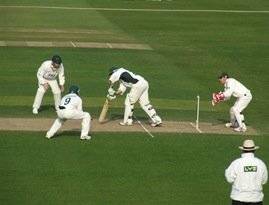This post was first published on March 30, 2011.
In this fast moving world, where people hardly find any time to enjoy, cricket was also dying with the reduction in number of spectators. The main reason could have been the length of games where test cricket is played for 5 days and the 50 over version would last for around 8 hours. Introduction of a new variant “twenty-20”made an immediate impact and attracted more people to the ground as well as to the galleries since the game is more of attacking type and last long for just 4 hours. This variant has given a new life to Cricket. I found another variant of cricket which might interest some of fading cricket fans, “Indoor Cricket”.
Indoor cricket shares many basic aspects of conventional cricket. The match is played between two teams of 8 players each. Each team plays 16 overs of 8 balls each. Though the pitch length in indoor cricket is same as that in the conventional cricket match, batsmen don’t have to run the whole distance since the non striker end is only half way down the pitch. Dismissal methods include LBW, mankad etc as in the conventional cricket. Scoring process differs as there are two areas of scoring. The first indoor test match was played between Australia and New Zealand in 1985.The first indoor cricket world cup was held in England in the year 1995. Since then the event is held once in every two to three years. The last world cup tournament was held in 2009 and Australia is the defending champions. Below mentioned is a patent application related to indoor cricket.
On 13th June 1980, Michael Jerrard Jones and Paul Richard Hanna of Indoor Cricket Arenas Pvt Ltd filed a patent application (AU 546741 B2) titled “Indoor Cricket” which was granted later. The invention discloses an apparatus for playing an indoor cricket game comprising a play area surrounded by wall, a roof overlaying the walls, a cricket wicket in the play area having set of stumps at each end and bowling crease marked at bowlers end and batting crease marked at batsman’s end of wicket. The playing arena has bonus run scoring zones and boundaries marked on the extreme ends.
The game of cricket has transformed into many forms and I am confident this form will take the game a long way.
Authored by Naveen
In this fast moving world, where people hardly find any time to enjoy, cricket was also dying with the reduction in number of spectators. The main reason could have been the length of games where test cricket is played for 5 days and the 50 over version would last for around 8 hours. Introduction of a new variant “twenty-20”made an immediate impact and attracted more people to the ground as well as to the galleries since the game is more of attacking type and last long for just 4 hours. This variant has given a new life to Cricket. I found another variant of cricket which might interest some of fading cricket fans, “Indoor Cricket”.
Indoor cricket shares many basic aspects of conventional cricket. The match is played between two teams of 8 players each. Each team plays 16 overs of 8 balls each. Though the pitch length in indoor cricket is same as that in the conventional cricket match, batsmen don’t have to run the whole distance since the non striker end is only half way down the pitch. Dismissal methods include LBW, mankad etc as in the conventional cricket. Scoring process differs as there are two areas of scoring. The first indoor test match was played between Australia and New Zealand in 1985.The first indoor cricket world cup was held in England in the year 1995. Since then the event is held once in every two to three years. The last world cup tournament was held in 2009 and Australia is the defending champions. Below mentioned is a patent application related to indoor cricket.
On 13th June 1980, Michael Jerrard Jones and Paul Richard Hanna of Indoor Cricket Arenas Pvt Ltd filed a patent application (AU 546741 B2) titled “Indoor Cricket” which was granted later. The invention discloses an apparatus for playing an indoor cricket game comprising a play area surrounded by wall, a roof overlaying the walls, a cricket wicket in the play area having set of stumps at each end and bowling crease marked at bowlers end and batting crease marked at batsman’s end of wicket. The playing arena has bonus run scoring zones and boundaries marked on the extreme ends.
The game of cricket has transformed into many forms and I am confident this form will take the game a long way.
Authored by Naveen



